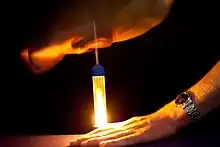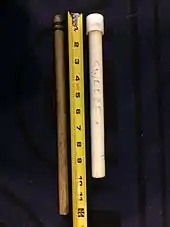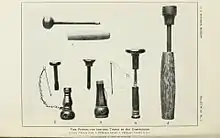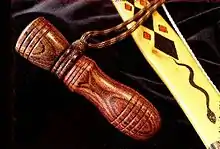
A fire piston, sometimes called a fire syringe or a slam rod fire starter, is a device of ancient Austroasiatic origin which is used to kindle fire. In Malay it is called "gobek api" . It uses the principle of the heating of a gas (in this case air) by rapid and adiabatic compression to ignite a piece of tinder, which is then used to set light to kindling.[1]
Description and use

A fire piston consists of a hollow cylinder sealed at one end and open at the other. Sizes range in length from 3 to 6 inches (7.5 to 15 cm) with a bore about 0.25 inch (6–7 mm) in diameter, to 10 to 14 inches (25 to 35 cm) with a bore about 0.5 inch (14 mm) in diameter. A piston with an airtight circular seal is fitted into the cylinder. A string packing lubricated with water or rubber gasket lubricated with grease is used to create an air-tight but slippery seal. At the end of the piston a small cavity is made, where tinder can be inserted without it being crushed during subsequent operations. The piston can be completely withdrawn from the cylinder for installation or removal of the tinder.
The piston (or cylinder) has a handle on the end to allow a firm grip to be applied to it, or a large enough surface area to strike it sharply without causing pain, while the cylinder (or piston) is braced or slammed against a hard surface. The compression of the air when the piston is quickly forced into the cylinder causes the interior temperature to rise sharply to over 400 °F (260 °C), the autoignition temperature of tinder. This is hot enough for the tinder in the piston face to ignite with a visible flash that can be seen, if the cylinder is made of translucent or transparent material. The piston is then quickly withdrawn, before the now-burning tinder depletes the available oxygen inside the cylinder. The smouldering tinder can then be removed from the face of the piston and transferred to a larger nest of tinder material. The ember is then fanned or blown upon vigorously to create a flame, at which time various stages of larger kindling can be added until built into a full-scale fire.
Ancient and modern versions of fire pistons have been made from wood, animal horns, antlers, bamboo, or metal. Today, fire pistons are commonly constructed from wood, metal, or plastic. Do-it-yourself designs have become available using wood dowels, PVC and copper pipe, and rubber O-rings, to build versions costing less than $2 USD each.
Principle of operation

Rapid compression of a gas increases its pressure and its temperature at the same time. If this compression is done too slowly the heat will dissipate to the surroundings as the gas returns to thermal equilibrium with them. If the compression is done quickly enough, then there is no time for thermal equilibrium to be achieved. The absolute temperature of the gas can suddenly become much higher than that of its surroundings, increasing from the original room temperature of the gas to a temperature hot enough to set tinder alight. The air in the cylinder acts both as a source of heat and as an oxidizer for the tinder fuel.
The same principle is used in the diesel engine to ignite the fuel in the cylinder, eliminating the need for a spark plug as used in the gasoline engine. The principle of operation is closer to the hot bulb engine, an early antecedent to the diesel, since the fuel (tinder) is compressed with the gas, while in a diesel the fuel is injected when the gas is already compressed and at a high temperature.
Fire pistons have a compression ratio of about 25 to 1. This compares with about 20:1 for a modern diesel engine, and between 7:1 and 11.5:1 for a gasoline engine. The fire piston is made deliberately narrow so that unaided human strength can exert enough force to compress the air in the cylinder to its fullest extent. To achieve a high compression ratio, the final compressed volume of the tinder and air must be small relative to that of the length of the piston tube. These two factors together mean that only a tiny amount of tinder can be lit by a fire piston, but this can be sufficient to light other tinder, and in turn to light a larger fire.
Tinders that ignite at a very low temperature work best. Easily-combustible materials such as char cloth or amadou work well as tinder, and can also hold an ember. By contrast, cotton fibers ignite at 455 °F (235 °C) and will flash brightly but do not hold an ember. The bright flash of light is sometimes sufficient for demonstration purposes, but will not start a persistent fire.
The construction of a hand-operated pump, such as an ordinary bicycle pump, is very similar except that the pump also has valves and a hose to deliver compressed air as an output. In the case of the pump, the heating of the compressed air is an undesired side effect. In both fire piston and pumps, the mechanism and lubricants must be chosen to resist high peak temperatures and pressures.
History
Southeast Asia and Madagascar

Fire pistons were invented by Southeast Asians (probably the Austronesian peoples). Their use was mostly concentrated in the Austronesian regions, particularly in the Malay Peninsula, the Philippines, Borneo, Sumatra, Java, some of the islands east of Java including Flores, and in Madagascar. They are also found in Burma, Thailand, and Laos in Mainland Southeast Asia, as well as parts of Yunnan and in Japan.[3][4][5][6]

Fire pistons in Southeast Asia were variously constructed of bamboo, wood, metal, ivory, bone, and horn. The main tube was typically around 3.25 in (8.3 cm) long and 0.5 in (1.3 cm) in diameter, with a bore size around 0.375 in (0.95 cm).[7] The end of the tube usually flared out into a small cavity used for holding tinder.[2] The tinder used was typically obtained from the leaf bases of palm trees and rattan vines and were usually stored in a tinder box carried along with the piston. They were reported to be known as lek phai tok in Thai; and gobek api in Malay (literally "fire mortar and pestle).[8]
The antiquity of the fire piston in Southeast Asia is unknown, but it definitely pre-dated the Austronesian colonization of Madagascar (c. 100-500 AD). It was one of the early definite proofs linking Madagascar with a Southeast Asian origin.[6]
The principles governing fire pistons were also used to construct Southeast Asian piston bellows with bamboo. These piston bellows could pump sufficient air into a furnace to produce temperatures high enough to melt metal, which led to the independent development of sophisticated bronze and iron metallurgy in Southeast Asia starting at around 1500 BC. Particularly in the development of bronze gongs (e.g. from the Dong Son culture) that were then exported in the ancient maritime trade networks of Southeast Asia.[6][9] These piston-bellows reached as far as Madagascar prior to European contact.[10] The bamboo piston-bellows technology was also adopted early by the Chinese, replacing the indigenous Chinese leather-bellows technology completely.[6][11]
Whether the European fire pistons were influenced by the Southeast Asian fire pistons was a matter of debate. But Balfour (1908) and Fox (1969) have demonstrated convincingly that the European fire pistons were independently discovered via air guns. Fox, however, tries to argue that the Southeast Asian fire pistons were introduced from Europe, but this is rejected as unconvincing by other scholars. The presence of derivative piston-bellows technology and the existence of fire pistons even in isolated and widely separated cultures, like the Kachin of northern Burma and the Igorot of highland Luzon, makes it definitely known that Southeast Asian fire pistons existed long before the European versions.[4][10]
Despite the independent invention of European fire pistons, it was the Southeast Asian fire pistons that inspired Rudolf Diesel in his creation of the diesel engine at around 1892, not the European versions (which had largely been replaced by matches by the late 19th century). Diesel was a student of the inventor Carl von Linde. He acquired the idea of the internal combustion engine after he witnessed Linde light a cigarette with a fire piston. This fire piston was acquired by Linde from Southeast Asia during a lecture in Penang.[5][12][13]
Europe
The first known documented fire piston in the West was made in 1745 by the Abbot Agostino Ruffo of Verona, Italy, who was making a pair of air guns for the king of Portugal, John V. While Ruffo was testing a gun's air pump for leaks by plugging its outlet with a scrap of wood, he noticed that, after he had pressurized the pump, the wood had been scorched. Subsequently, he found that tinder was ignited by the pump. Ruffo made an apparatus to study the phenomenon further,[14] but his invention was not popularized.
It is recorded that the first fire piston made its wider debut in front of scientists in 1802,[15] and was patented in 1807 simultaneously in both England and France.[16] Fire pistons, or "fire syringes" as they were called then, enjoyed a brief period of popularity in parts of Europe during the early nineteenth century, until being displaced by the friction match invented in 1826.[17]
In the US, descriptions have been published for many years.[18][19][20]
See also
- Luthang, a Filipino bamboo children's toy gun using the same principle and construction
- Fire striker
- Firelighting
References
- ↑ Manansala, Paul K. (2006-03-24). "Metallurgy, Southeast Asian (Glossary) Piston bellows". Retrieved 2007-05-28.
- 1 2 Hough, Walter (1926). Fire as an Agent in Human Culture. Smithsonian Institution, United States National Museum. pp. 109–110. ISBN 9780598370822.
- ↑ Hough, Walter. 1928. Fire-making apparatus in the United States National Museum. Proceedings of the United States National Museum 73(2735):1–72.
- 1 2 Balfour, Henry. 1908. The fire piston. Annual report of the Board of Regents of the Smithsonian Institution, showing the operations, expenditures and condition of the institution for the year ending June 30, 1907, 565–593. Washington, DC: Government Printing Office.
- 1 2 Ogata, Masanori; Shimotsuma, Yorikazu (October 20–21, 2002). "Origin of Diesel Engine is in Fire Piston of Mountainous People Lived in Southeast Asia". First International Conference on Business and technology Transfer. Japan Society of Mechanical Engineers. Archived from the original on 2007-05-23. Retrieved 2007-05-28.
- 1 2 3 4 Needham, Joseph (1965). Science and Civilisation in China: Volume 4, Physics and Physical Technology, Part 2, Mechanical Engineering. Cambridge University Press. pp. 140–141. ISBN 9780521058032.
- ↑ Tilton, Buck (2010). The Complete Book of Fire: Building Campfires for Warmth, Light, Cooking, and Survival. Menasha Ridge Press. pp. 34–35. ISBN 9780897328296.
- ↑ Jamison, Richard; Jamison, Linda (2007). Primitive Skills and Crafts: An Outdoorsman's Guide to Shelters, Tools, Weapons, Tracking, Survival, and More. Skyhorse Publishing Inc. pp. 163-176. ISBN 9781602391482.
- ↑ Hall, Kenneth R. (2010). A History of Early Southeast Asia: Maritime Trade and Societal Development, 100–1500. Rowman & Littlefield Publishers. p. 4. ISBN 9780742567627.
- 1 2 Needham, Joseph (1970). Clerks and Craftsmen in China and the Est. Cambridge University Press. pp. 155–167.
- ↑ Wertime, Theodore A. (1961). The Coming of the Age of Steel. Brill Archive.
- ↑ Diesel Story (Film). Prelinger Archives: Shell Oil. 1952. Retrieved 2007-02-16.
- ↑ Gurstelle, William (2009). "Rudolf Diesel and the Fire Piston". Make. Sebastopol, California: O'Reilly Media. 19: 166–168. ISSN 1556-2336.
- ↑ See:
- "Nuova Osserv(azioni) sopra l'Aria condensata dentro d'una Siringa" [New observation on air condensed inside a syringe] (1745) Giornale de' Letterati, 1 : 307–308. (in Italian)
- Govi, Gilberto (1876) "Sull'invenzione dell'Accendi-fuoco Pneumatico" [On the invention of pneumatic fire lighters], Atti della Accademia Nazionale dei Lincei, 2nd series, 3 (2) : 41–44. (in Italian)
- Govi, Gilberto (1876) "Sur l'invention du briquet pneumatique" (On the invention of the pneumatic lighter), Comptes rendus, 83 : 541–543. (in French)
- (Editorial staff) (September 21, 1876) "Societies and Academies: Paris: Academy of Sciences, Sept. 4," Nature, 14 : 468.
- ↑ In 1802, a worker in St. Etienne, France, who had long been making improvements to air rifles, noticed that (1) when the gun was fired in the dark, it emitted a bright light, and (2) if there was lint present in the gun when the gun was pressurized, the lint would become scorched or even ignite. Word of these observations reached Messrs. Eynard, Haèz, and Gensoul, who confirmed them and publicized them. Joseph Mollet (1756–1829), a professor of physics in Lyon, learned of these facts and investigated them. In 1804, he presented his findings to the Academy of Lyon. See:
- Mollet, J., Mémoire sur deux faits nouveaux, l'inflammation des matières combustibles et l'apparition d'une vive lumière obtainue par la seule compression de l'air; lu dans la séance publique de l'Académie de Lyon le 27 mars 1804 [Memoir on two new facts, the ignition of combustible materials and the appearance of a bright light obtained only by the compression of air; read in the public session of the Academy of Lyon on the 27th of March 1804] (Lyon, France: Ballancre père et fils, 1811). In 1804, Mollet suggested that his findings could be used to make a fire piston. From p. 13: "Ce procédé nouveau assure tellement la réussite de l'expérience, que l'appareil qu'on vient de décrire pourrait être considéré comme une espece de briquet." (This new procedure so assures the success of the experiment that the apparatus that was just described could be considered as a type of lighter.) Mollet appended (pp. 30–31) the names of several inventors who had made fire pistons: Mr. Dumotiez (or Dumotier) of Paris; Mr. Dubois, a foundry worker from Lyon; and Mr. Thibaudier, another resident of Lyon.
- Dhombres (1811) "Rapport sur un mémoire de M. Mollet, relatif à la production de la lumière et de chaleur par l'effet de compression" [Report on a memoir by Mr. Mollet, regarding the production of light and heat by the effect of compression], Notice des Travaux de l'Académie du Gard pendant l'année 1811, part 1, pp. 175–182.
- (Pictet) (1803) (Letter from Prof. Pictet to Mr. Tilloch), Philosophical Magazine, 14 : 363–364.
- (Editorial staff) (1803) "Flash from an air-gun," Journal of Natural Philosophy, Chemistry and the Arts, 4 : 280.
- Hart, John (1823) "On light produced by the discharge of an air-gun," The Quarterly Journal of Science, Literature and Art, 15 : 64–66.
- Thénard, Louis Jacques (1830) "Observations sur la lumière qui jaillit de l'air et de l'oxigène par compression" (Observations of the light that springs from air and oxygen as a result of compression), Annales de chimie et de physique, 2nd series, 44 : 181–188.
- ↑ In 1806, a "Colonel Grobert", who probably was Jacques François Louis Grobert (1757-181?), a colonel in the French artillery, conceived a fire piston (briquet pneumatique, pneumatic lighter), but he had it fabricated by a professional maker of scientific instruments in Paris, "Dumotier" (variously spelled Dumoutier, Du Moutier, and Dumotiez). See:
- Grobert (April 1806) "Moyen de produire des inflammations par l'air comprimé" (Means of producing ignitions by compressed air), L'Esprit des journaux, françois et étranger, 4 : 139–145.
- Morelot, Simon, Histoire naturelle appliquée à la Chimie [Natural history applied to chemistry] (Paris, France: F. Schoell and H. Nicolle, 1809), vol. 1, p. 94. From page 94, footnote 1: " (1) Inventé par le colonel Grobert, exécuté par M. Dumotier. " ((1) Invented by Colonel Grobert, executed by Mr. Dumotier.)
- Krehl, Peter O. K., History of Shock Waves, Explosions, and Impacts (Berlin, Germany: Springer Verlag, 2009), p. 273.
- (Staff) (1807) "Specification of the Patent granted to Richard Lorentz, … for certain inventions (communicated to him by Foreigners residing abroad) of different Machines or Instruments, one of which will produce instantaneous Light, and the other instantaneous Fire. Dated February 5, 1807." The Repertory of Arts, Manufactures, and Agriculture, 2nd series, 11 : 250–253.
- ↑ Fox, Robert. 1969. The fire piston and its origins in Europe. Technology and Culture 10:355–370.
- ↑ Smiley, Edwin (February 1915) "Primitive methods of making fire," Boys' Life, 4 (12) : 9.
- ↑ Post, Augustus (September 1929) "The Landing Field: The Diesel engine," Boys' Life, 19 (9) : 44.
- ↑ Spencer, Billie (March 1974) "Man and fire," Boys' Life, 64 (3) : 6.
Bibliography
- Arbor Scientific, Tools That Teach, Fire Syringe P1-2020; http://www.arborsci.com/Data_Sheets/P1-2020_DS.pdf
- Balfour, Henry (1907) "The fire piston," Annual Report of the Board of Regents of the Smithsonian Institution, pp. 565–598.
- Fox, Robert (July 1969) "The Fire Piston and Its Origins in Europe", Technology and Culture, 10 (3) : 355–370.
- Jamison, The Remarkable Firepiston Woodsmoke (1994) Menasha Ridge Press, Birmingham AL ISBN 0-89732-151-0
- Jamison, Richard with Mel Deweese, "The remarkable fire piston" in: Richard and Linda Jamison, Primitive Skills and Crafts: An outdoorsman's guide to shelters, tools, weapons, tracking, survival, and more (New York, New York: Skyhorse Publishing, 2007), pp. 163–176.
- Rowlands, John J. The Cache Lake Country (1947); W. W. Norton and Company, Inc., New York, NY
External links
- The Firepiston: Ancient Firemaking Machine
- YouTube Instructions on Making Fire Piston
- University of Bristol, School of Chemistry: The Fire Piston
- A collection of antique fire syringes
- An equation describing the change in temperature during compression
- Photographs of a fire syringe
- The Naked Scientists - How a fire piston works